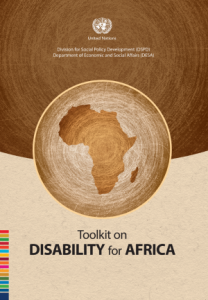- Main page: Handbook for Parliamentarians
- Habilitation and rehabilitation
- Accessibility
- Education
- The Cost of inclusive education
- Work and employment
- Legal capacity and supported decision-making
EDUCATION
There are many potential barriers to education for persons with disabilities, especially in developing countries. These include:
- Poverty
- Overcrowded schools
- Lack of trained teachers
- Lack of reasonable accommodation and support for students with disabilities
- Inaccessible facilities
- Inaccessible curricula
- Poor or inaccessible transport
- Social stigma and lack of familiarity with the school environment
Current estimates suggest that the school enrolment rates of children with disabilities in developing countries are as low as 1 to 3 per cent; therefore, approximately 98 per cent of children with disabilities do not go to school and are illiterate. As long as such a large number of children with disabilities do not attend school, the millennium development goal of achieving universal primary education will remain elusive. However, research shows that children, including those with significant disabilities, who are included in regular education are more likely to finish school, go onto post-secondary education and training, get jobs, earn good incomes, and become active members of their communities.
The Convention covers many aspects of education at different stages of life (article 24). Its priority is to encourage children with disabilities to attend school at all levels (article 24 (2) (a)). The Convention asserts that the best way to do this is to focus on the best interests of the child (article 24 (2) (b)). The Convention also addresses the education needs of the large number of adults with disabilities who are uneducated or undereducated due to a lack of opportunity or access when they were children. It also recognizes the importance of learning over one’s lifetime (article 24 (5)), including for those adults who acquire disabilities and, therefore, want or need further education to support their ability to work, including vocational training and university-degree programmes.
The approach to education promoted by the Convention is based on a growing body of evidence that shows that inclusive education not only provides the best educational environment, including for children with intellectual disabilities, but also helps to break down barriers and challenge stereotypes. This approach helps to create a society that readily accepts and embraces disability, instead of fearing it. When children with and without disabilities grow up together and learn, side by side, in the same school, they develop a greater understanding and respect for each other.
I got higher exam results than all the students in the same year group as me who were in the special school: and not because I’m cleverer, but just because of the opportunities I’ve had and the opportunities I’ve been given.
Lucia Bellini, blind student (UK)
The transition from a school system relying on specialized education to an inclusive system needs to be carefully planned and implemented to protect the needs and best interests of the child. Support from parents, community leaders and teachers is a prerequisite. To be inclusive, the general education system should:
- Provide suitable equipment and teaching materials for persons with disabilities;
- Adopt teaching methods and curricula that embrace the needs of all children and students, including those with disabilities, and promote acceptance of diversity;
- Train all teachers to teach in an inclusive classroom and encourage them to support each other;
- Provide a range of support that meets the diverse needs of all students, including students without disabilities, to the greatest extent possible; and
- Facilitate the learning of Braille and sign language so that children who are blind, deaf or deaf-blind can have access to education and can communicate.
BEYOND THE EDUCATION SYSTEM
Access to education is not only about the education system. Even if a school allows a child with disabilities to enrol, a lack of accessible transport may make getting to school difficult or impossible. Sometimes the school itself is inaccessible. Changing the physical infrastructure may seem daunting, but it need not be. Over time, as buildings need to be refurbished, they could be retrofitted to include accessible design features.
In the future, it should be mandatory for all new buildings, including educational facilities, to be accessible. This includes not only features that enable wheelchair users to enter the building, but also such things as Braille signage and appropriate lighting for those with low vision. The cost of including accessible features at the time of construction can be minimal, with studies indicating that such accommodations add less than 1 per cent to construction costs.
The cost of inclusive education
Inclusion is often (mis)conceived as prohibitively expensive, impractical, unsustainable or a strictly disability-specific issue. However, not all positive measures are costly. Several countries have already developed cost-effective programmes to promote inclusiveness with limited resources. States should use available resources, focus on achieving clear goals, and ensure sustainability of education funding in the short, medium and long term. Cutting funding to an inclusive education system has dramatic adverse effects not only for individuals, but also for the policy of inclusion, in general.
Inclusive educational settings are generally less expensive than segregated systems. This finding is consistent with the notion that a single, integrated educational system tends to be cheaper than two separate ones. A single system lowers management and administration costs. Transport, too, is less expensive, since segregated settings usually involve individuals from a larger geographical area. Experience has shown that as many as 80 to 90 per cent of children with specific education needs, including children with intellectual disabilities, can easily be integrated into regular schools and classrooms, as long as there is basic support for their inclusion.
CHECKLIST FOR PARLIAMENTARIANS
How I can help make education more inclusive
- Disseminate inclusive-education methodologies as an integral part of teacher-training syllabuses.
- Encourage persons with disabilities to train as teachers.
- Use pyramid-training techniques where teachers, once trained in inclusive-education methodologies, teach other teachers.
- Promote peer-tutoring programmes, whereby higher-level students assist junior students.
- Promote partnerships between schools and parents.
- Link existing community-based rehabilitation networks to inclusive-education initiatives.
- Ensure reasonable accommodation is provided in child assessment.
- Turn existing special schools into resource centres.
- Set up a reporting mechanism to monitor school registration and completion by children with disabilities.




